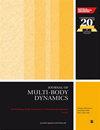考虑路堤角度的主动倾斜控制窄倾三轮车仿真研究
IF 1.9
4区 工程技术
Q3 ENGINEERING, MECHANICAL
Proceedings of the Institution of Mechanical Engineers Part K-Journal of Multi-Body Dynamics
Pub Date : 2023-03-20
DOI:10.1177/14644193231163631
引用次数: 2
摘要
采用电动窄倾三轮车可以减少交通拥堵、停车位和车辆排放等问题,也可以为低收入人群提供一种经济、安全的交通方式。根据2017年能源技术展望,到2060年,通过采用电动交通工具,从油井到车轮的全球温室气体排放量可减少1.3亿吨二氧化碳当量。本研究提出了一种新的和改进的SDTC策略和性能参数,该策略考虑了道路倾斜角度(RBA),以显示在感知横向加速度和期望轨迹方面对侧翻安全性、乘坐舒适性的不利影响。此外,本研究还确定了主动倾斜控制车辆在斜坡上停车时考虑RBA的重要性。提出了考虑实时RBA的SDTC方法的简单电子控制体系结构,以解决SDTC的局限性及其补充优势。本研究评估了车辆在倾斜道路上不断转向和停车的情景。多体模型用于捕获车辆的动态特性,而倾斜驱动系统(TAS)和主动转向(AS)系统的特性则以传递函数(TF)的形式结合,使用系统识别方法进行估计。结果表明,在SDTC中加入实时RBA使其能够在所提出的控制策略下保持稳态扭矩和感知侧向加速度接近于零,并保持车辆在倾斜表面上的直立状态。可以得出结论,RBA补偿提高了在斜坡上停车或行驶时操控车辆的便利性,而无需对控制系统进行重大更改,这也使其成为身体残疾人士的可行选择。本文章由计算机程序翻译,如有差异,请以英文原文为准。
Simulation-based study on active tilt controlled narrow tilting three-wheeler considering road bank angle
The issues like traffic congestion, parking space and vehicular emission can be reduced by adopting electric narrow tilting three-wheelers, which can also provide a cost-effective and safe mode of transport for low-income people. According to energy technology perspectives 2017, well-to-wheel global greenhouse gas emissions can be reduced up to 1.3 GtCO2-eq by 2060 by adopting electric mobility. This study presents a new and modified SDTC strategy and performance parameters that takes Road Bank Angle (RBA) into account so as to exhibit the adverse effects on rollover safety, ride comfort in terms of the perceived lateral acceleration and desired trajectory. Besides, this study identifies the importance of the RBA consideration in active tilt controlled vehicle for the scenario of parking on sloped surface. Simple electronic control architecture of the SDTC approach with real-time RBA consideration is proposed to address the limitations of SDTC and its supplementary advantages. This study evaluates the scenario of constant turn manoeuvre and vehicle parking on the banked roads. A multi-body model is used to capture the dynamic characteristics of the vehicle, whereas a characteristic of the Tilt Actuation System (TAS) and Active Steering (AS) system is incorporated in the form of a Transfer Function (TF) estimated using a system identification approach. The results indicate that the inclusion of a real-time RBA in the SDTC enables it to maintain steady-state torque and perceived lateral acceleration close to zero with the proposed controlled strategy, and it also keeps the vehicle upright on the sloped surface. It may be concluded that RBA compensation improves the ease of handling the vehicle while parking or riding on a sloped surface without significant control system alterations, which also makes it a viable alternative for physically disabled people.
求助全文
通过发布文献求助,成功后即可免费获取论文全文。
去求助
来源期刊

CiteScore
4.10
自引率
11.10%
发文量
38
审稿时长
>12 weeks
期刊介绍:
The Journal of Multi-body Dynamics is a multi-disciplinary forum covering all aspects of mechanical design and dynamic analysis of multi-body systems. It is essential reading for academic and industrial research and development departments active in the mechanical design, monitoring and dynamic analysis of multi-body systems.
 求助内容:
求助内容: 应助结果提醒方式:
应助结果提醒方式:


